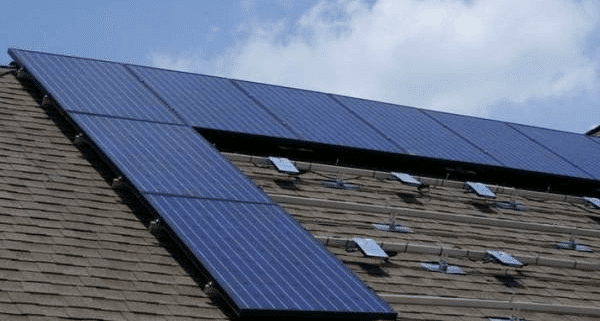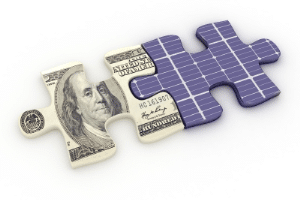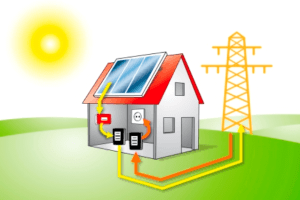How much for a solar panel system?
In order to determine how much it would cost you to get solar panels installed to cover your power bill or at least reduce your costs, you need to determine the following:
- How many kilowatt hours will your home use per month? (discover the details of your electric bill)
- How much roof area do you have to install panels on? (south facing roof is preferred)
- How many sun hours will your desired location get per day on average? (this is averaged over the course of a year)
- How much are you able to afford to invest in order to offset your energy expenses?
An average home in the United States requires approximately 20 – 24 kWh of electricity everyday. An array of panels able to produce this much power are about 4 kW or more in size (based on 5 sunlight hours per day) and the price runs from $15,500 – $20,000 installed (not implementing any incentives).
Determined by within pricing as of August 2012, a 24 cell 786 kWh grid tie system could be approximately $8,630 before any suitable financial incentives. The price does include the cost of installation or racks into consideration.
Looking at worldwide prices as of 2009, the average cost per W installed of a 2-5 KW residential solar energy system was $4.70 within Japan, $7.70 in Philippines and from $5-$11 in the United States based on a report completed by (Renewable & Sustainable Energy Reviews).
Prices vary based on building and techniques used in the configuration, the type and model of equipment used and what company does the installation. The type superiority panel as well as the size of your array affects the final expense of an installation. Manufacturers price each panel based on the effectiveness and longevity. Panels that will retain their efficiency in great length are usually more expensive. Monocrystalline panels include the most costly but generate the most watts per area, so you will need fewer panels and will not need as much space. Building completely integrated panels are also on the expensive side, but they are the best choice when appearance is crucial.
Your neighborhood and city can also have a big impact on the ultimate price of a solar energy project. The federal government and local governments in many countries offer financial incentives to make buying and installing programs more affordable. Prices are also depend on local weather conditions. Due to limited sun hours per day, the fee per kilowatt installed will be higher than in sunnier countries like Mexico.
Types and Benefits with Solar Panels
Crystalline panels are the most popular type of solar panel. This technology has existed for about 50 years and was first developed in order to power satellites. They are capable of being up to 20% efficient. This technology are highly reliable (Twenty-five year warranties are common) and produce related results in terms of output effectiveness. The primary downsides of using crystalline are generally that they can be bulky, pricey, prone to damage, are rigid and require a lot of labor to set up. That said, they are often the best choice for any residential solar energy system. They are available in two varieties: monocrystalline and polycrystalline.
Monocrystalline plastic panels are made up of single-crystal wafer cells cut from, cylindrical crystal ingots. They can be cut completely round to minimize waste, but they are frequently trimmed into other, a lot more square-like shapes (see below). Considering that each is made from a single gem, the cells have a uniform, fast color. They are the most efficient cells available today (they produce much more power per square foot), nonetheless they cost more than all others.
Polycrystalline plastic panels are made of multi-crystal wafer cells lower from square ingots that are manufactured by pouring molten silicon into a mold. So it can be cut into square wafers to minimize waste. Each is made up of a lot of random crystal formations which make it various colours of blue. These are slightly less energy efficient, and also cheaper than monocrystalline panels.
Thin motion picture modules are very inexpensive, and also quite inefficient (require more area per watt produced). Their efficiency is 10% or less and their long-term durability is often questioned. They are less expensive given that they require less of the active material to function. In fact, they can be made microscopically thin, flexible and lightweight and are lodged on a sheet of goblet or metal instead of needing to grow ingots and slice wafers. Cadmium telluride (CdTe) is among the most cost effective thin film technology. Amorphous silicon is material used to create panels that can be molded to the shape of almost any surface. Almost all of the research and development of solar cells is currently being focused on thin film systems.
Building integrated photovoltaic solar panels (BIPV) look like an integral part of a roof since they are the same size and shape while shingles. They have lower efficiency and are more expensive as compared to other panel types because of their size. These are most effective on large roofing in very sunny areas.
Solar Panels Cost Matrix Water Home heating Solar Panels:
Low End water heating Solar Panels
- Range $100 – $3,500 – Water heating for 2 or Three bedroom apartments
Medium end water heating Solar Panels
- Range $3,500 – $7,000 – Swimming Pool heat and home drinking water heating
High End water heating system Solar Panels
- Range $7,000 : $10,000 – Water Heating for entire individual family home (2500 Sq ft ) along with Solar Swimming Pool Heaters.
Solar power systems Cost Matrix air Heating Solar power systems:
Low end air heat solar panels
- Range $500 – $2,500 – Heating one particular room in a house along with self installation
Medium end air heating solar panels
- Range $5,000 – $20,000 – Heating apartments Two bedroom apartments, townhouses( 1600 Sq feet) with professional installations
High end air heating solar panels
- Range $25,000 and above – Heating an entire single family homes usually with professional installations
Solar power panels Cost Matrix Photovoltaic Solar Panels:
Low end Photovoltaic solar panels
- Range $10,000 – $15,000 – For a home which needs simply 1KW electric power
Medium end PV solar panels
- Range $15,000 – $25,000 – For a home which needs 3KW electric power
High end Sun Solar Panels
- Range $25,000 – 45,000 – For a home which needs 5KW electric power.




